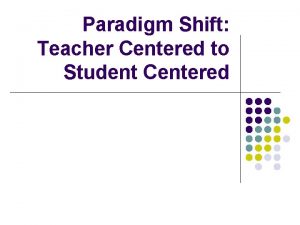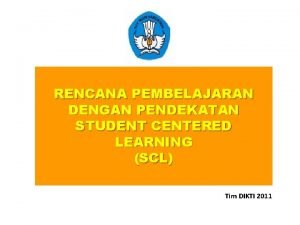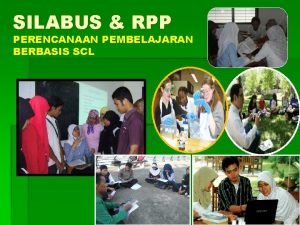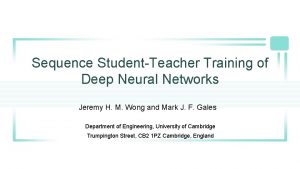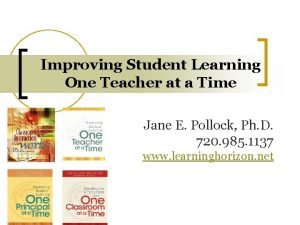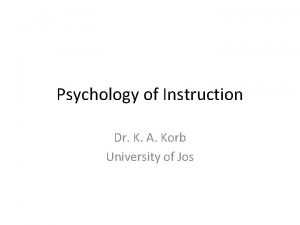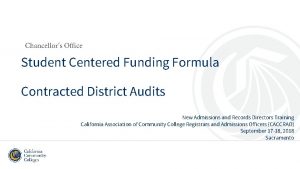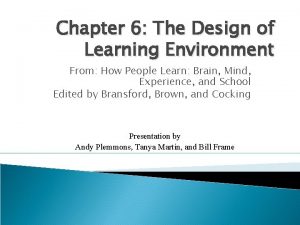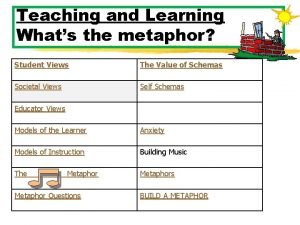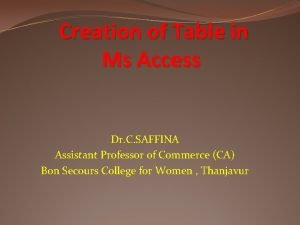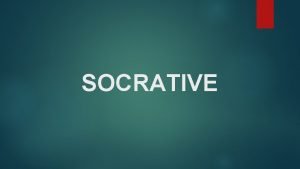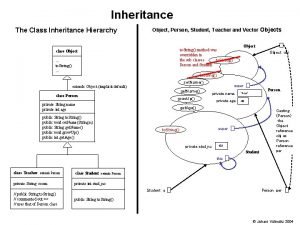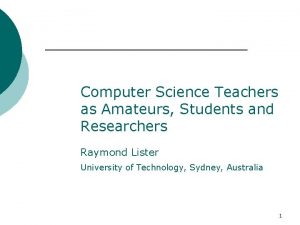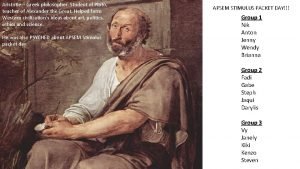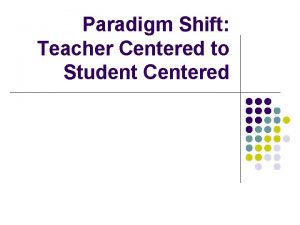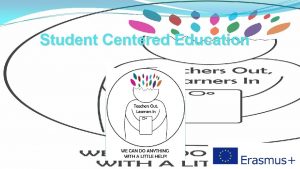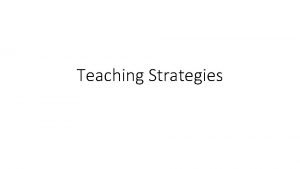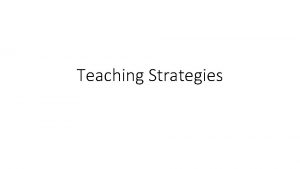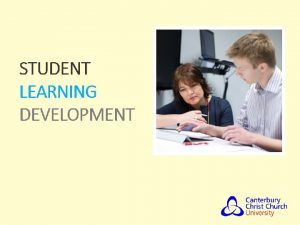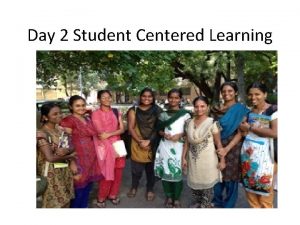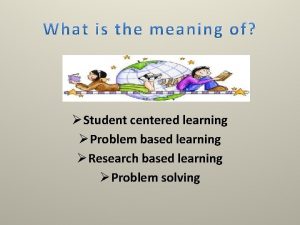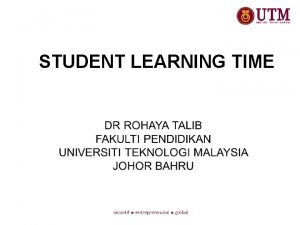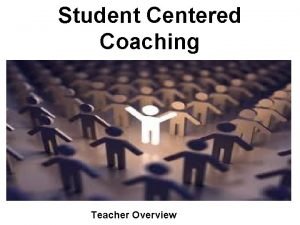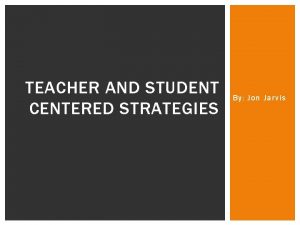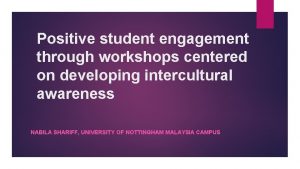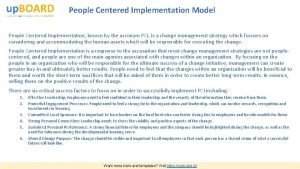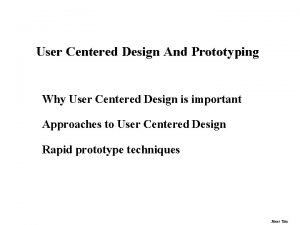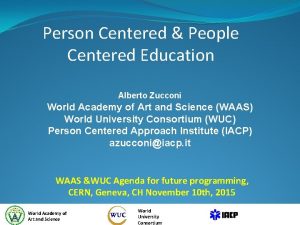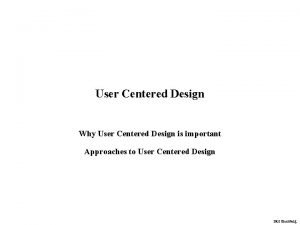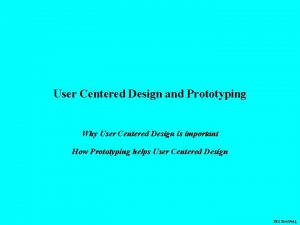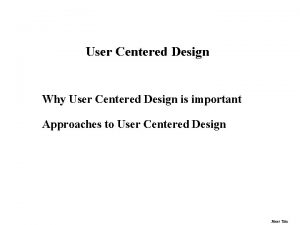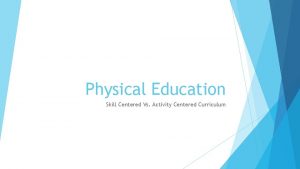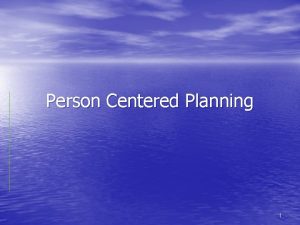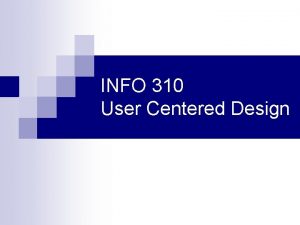From Teacher Centered to Student Centered Learning Developing


























- Slides: 26

From Teacher Centered to Student Centered Learning: Developing Modern ICT Supported Learning in Eduardo Mondlane University, Mozambique Cape Town, 6 -10 April 2015 Xavier Muianga 1, Tina Klonsri 2, Matti Tedre 3 & Inocente Mutimucuio 4 1 xavier. muinaga@uem. mz, 2 tinaklomsri@gmail. com, 3 matte. tedre@acm. org, 4 inocente. mutimucuio@uem. mz 1 & 4 Faculty of Education - Eduardo Mondlane University, Mozambique 2 & 3 Department of Computer and System Science – DSV, Stockholm University, Sweden

Presentation Outline • Introduction • Aim and Research Questions • Literature Review • Organization of Course • Methodology • Some Results • Conclusions

Introduction 1. Today's society requires graduates with competencies in various domains: - Specific professional competencies, Ex. : mechanical engineering, biology teacher, etc. - Generic competencies Ex. : critical thinking, teamwork, communication, research, lifelong learning, etc. 2. Information and Communication Technology (ICT) in education to support teaching and learning is a wide-spread practice.

Introduction 4. Curricular evaluations at UEM faculties found: - Students continue as consumers of knowledge transmitted by lecturers; - ICTs are not used effectively as a tool to support teaching and learning - (UEM, 1999; Mandlate, 2003; UEM, 2012)

Introduction 4. Eduardo Mondlane University (UEM) has started a process of curricular reform in almost all faculties. • Student-centered learning (SCL) and competencybased model to assure the highest quality in teaching and learning processes; • The use of ICT as tool for teaching and learning. (UEM, 2008 -2012).

Aim and Research Questions The aim of the study was to explore : • (1) students’ perceptions of student-centered learning in the course ‘ICT in Environmental Education’; • (2) the role of web 2. 0 tools in facilitating SCL and competency development, and; • (3) to what extent the intervention contributed to the development of students’ generic competencies.

Aim and Research Questions The central research questions for the study are: • How does the adoption of SCL contribute to students’ generic competence development in a course about ICT in Environmental Education, as perceived by the students? • How does the use of web 2. 0 tools in a course about ICT in Environmental Education support the adoption of SCL, as perceived by students?

Literature Review SCL approach is “a learning environment in which knowledge is constructed by students and the lecturer is a facilitator rather than (merely) the presenter of information”. Kember (1997). SCL approach: - The student at the centre; - Indication how the process unfolds; - Underline constructivism as learning approach; and, - Indicates the lecturer roles as crucial for success of student learning.

Literature Review Student-centered learning is a broad approach that includes active learning experiences that is self-paced and/or cooperative learning. (Brent, 1996, p. 43) SCL approaches the importance of give students the responsibility for their own learning and for engaging in activities, such as discussing different topics with peers, writing essays, and exploring others’ attitudes, values, and opinions

Literature Review Learning theories related with SCL self-regulated learning; student approaches to learning; collaborative learning; intrinsic motivation; metacognitive skills and strategies.

Literature Review Other challenges of implementation of SCL in developing countries: shortage of staff trained on SCL; teachers’ lack of confidence in technology; limited resources and large class sizes; both teachers and learners to adapt to the new roles; and their traditional cultural values (Moeller & Reitzes, 2011; O’Neill & Mc. Mahon, 2005; Tedre, et al. , 2011; …).

Methodology 1. Action Research Strategy: - Improving teaching abilities of the main researchers - Improving the teaching and learning approaches across the university as part of the process of curricular reform.

Methodology 2. Population and Sampling : - Population: a class of 29 Students - Sample: 8 students 3. Instruments: - Interviews: conducted with two pairs of students and 4 single students in different stages across the period of the study. - The Interviews were transcribed, coded, and categorized - Content analysis was used to interpret student activities in the LMS, and across the web 2. 0 websites produced by the students;

Methodology The study is divided into four major parts; (a)the design of the course; (b)the design of SLC approach (c) the use of web 2. 0 tools; and, (d)evaluation of the first three parts. This study reports on interviews and content analysis of students work.

Methodology Organization of Course: - It was run in the first year of the Environmental Education program - It was organized on the Learning Management System, named Chissimba, - The students were trained to use Chissimba - 8 groups of 4 or 3 students had been formed - Every two weeks the students were changing their membership to another group

Methodology Activities of the Course: - Each group had to choose an environmental problem experienced from everyday life - Most of the time students work on activities in groups or individually - Students also searched some information on the Internet about these problems and developed content to solve them - Use the Web 2. 0 tools selected, with the purpose of educating people about solving identified problems , as mentioned above - The content developed included videos and photographs produced by students using mobile phones and digital cameras.

Methodology Duration of the Course: - According to the curriculum design: 8 weeks duration 6 hours of face to face contact per week 18 hours of independent work per week

Results and Conclusions 1. Students talking about the valuable contribution of the SCL approach to their competence development: Rosa: “ I liked the way the lecturers organized this course … it helped us to know our environmental problems better… and how we worked intensively on course content … also … I learned to use various tools from the Internet with the help of our colleagues” The interviews with students also revealed that the collaboration between students helped some of them to learn and achieve what was expected in the course, as well as developing critical thinking. João: “At the beginning of this course … I could not read the problems of my colleagues … understand formulate a constructive judgment. But now I can understand how to help my colleagues to improve their work in formulating problems … as well as to improve my work after seeing the work of other colleagues”

Results and Conclusions - Students were motivated to constantly learning; - The SCL approach used seemed to be very effective because the students achieved the learning outcomes; -from their statements, students seemed to have developed different types of competencies: Ex: critical thinking, problem solving, communication, collaboration, media literacy, information literacy, and other skills through the use of Web 2. 0 tools.

Results and Conclusions The integration of web 2. 0 tools and Internet in the course supported the adoption of SCL. The web 2. 0 tools enhanced and supported students’ learning activities by allowing them to write, collaborate, research, analyze, and publish what they have learnt. By offering means for activities that are central for SCL, web 2. 0 played a crucial role in the course.

Results and Conclusions • Students perceived the organization of the course as fun and this increased their intrinsic motivation; • All students improved their technology skills over the course of eight weeks; • SCL combined with modern technology is an enjoyable way to learn and this motivates students;

Results and Conclusions In term of Collaborative learning; • Group assignments encouraged communication between students; • Benefitted the development of students’ interpersonal skills, as well as knowledge sharing and learning.

Results and Conclusions In term of Pedagogy: • The possibility to choose a real-life environmental problem was appreciated among the students; • Students showed that they could use available technology in an efficient way to solve the problems they were faced with; • Efficient use of technology promoted students’ problem solving skills; • The results indicate that most students learned to think critically and give constructive feedback to others.

Results and Conclusions The implementation of SCL faced some problems: • Not all students embraced the introduction of SCL; • Not all students were active in the use of available technology; • Students were not used to the structure and their new roles in SCL; • Some students were used to receive a lot of assistance from the lecturers and presumed to receive it during the course as well; • When they had to work independently, they felt insecure and confused.

Results and Conclusions Some challenges for UEM to implement SCL: • Should invest more in lecturer training on the use of SCL in order to fulfill the requirements of the pedagogical approach based on competence development; • The design of this course can be adapted to fit other courses at the university; • Disseminate the results of this study to ensure effective implementation of SCL approach combined with web 2. 0 tools;

THANK YOU
 Stock image
Stock image Contoh rpp berbasis student centered learning
Contoh rpp berbasis student centered learning Rpp metode scl
Rpp metode scl Good morning campers todays challenge is simple
Good morning campers todays challenge is simple Improving student learning one teacher at a time
Improving student learning one teacher at a time Student teacher deep learning
Student teacher deep learning Improving student learning one teacher at a time
Improving student learning one teacher at a time Sls learning space login
Sls learning space login Teacher centered approach
Teacher centered approach Advantages and disadvantages of pedagogical analysis
Advantages and disadvantages of pedagogical analysis Student centered funding formula
Student centered funding formula Cuadro comparativo e-learning b-learning m-learning
Cuadro comparativo e-learning b-learning m-learning Assessment centered learning environment
Assessment centered learning environment Erf promotion for teachers
Erf promotion for teachers Good afternoon teacher and my friend
Good afternoon teacher and my friend Metaphor teacher-student relationship
Metaphor teacher-student relationship Direct method presentation
Direct method presentation Teacher student database example
Teacher student database example Every student deserves a great teacher
Every student deserves a great teacher Socrative com student login
Socrative com student login Student teacher
Student teacher Amateur teacher student
Amateur teacher student Who is plato's teacher
Who is plato's teacher Good morning student how are you today
Good morning student how are you today Teacher student conversation
Teacher student conversation Your last weekend
Your last weekend We ...... a big piece of wood last saturday. (see)
We ...... a big piece of wood last saturday. (see)
